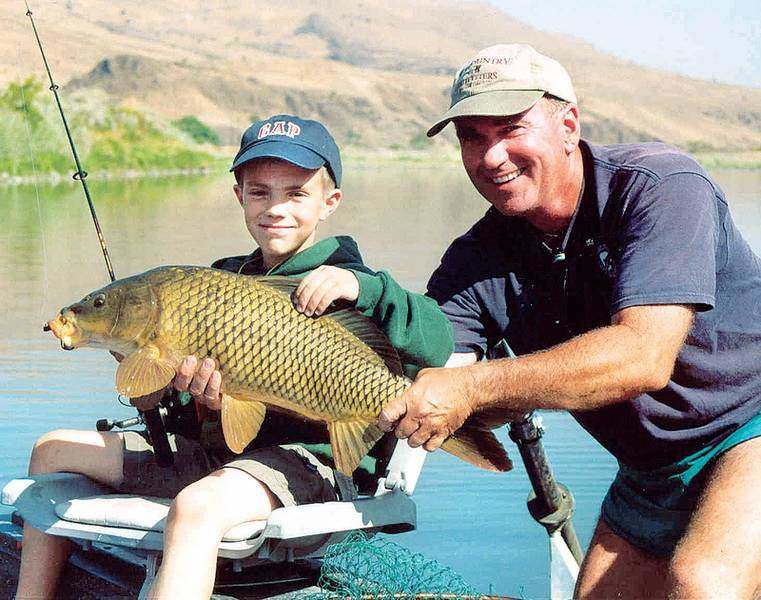Common carp:an uncommon challenge
Published 4:00 am Thursday, February 15, 2007

- D.J. Lario, left, of Salem caught this carp on a root-beer colored grub while fishing for bass with Mah-Hah Outfitters on the John Day River. The fish battled for 10 minutes while the guide, George Hadley, right, fought to keep D.J. in the boat.
I confess to being a bit of a salmonid snob in years past. As a kid, I fished for steelhead, salmon and trout. Bass came number four on the priority list, with bluegill and crappie a distant fifth and sixth.
Carp I classed with suckers as ”bottom feeders,” not worthy of my attention. But I came to see things from a different point of view when a 20-pound carp sucked down my salmon eggs and gave me a beating.
Cyprinus carpio is capable of thrashing your tackle. I’ve seen people walk away with splintered rods, broken lines and bruised egos. One friend of mine lost his rod and reel to a Columbia River carp when he turned his back for a moment.
How big do they get? An uncommonly big 75-pound, 11-ounce common carp from France set the world record in 1987. On this continent, a 57-pounder from the Potomac holds the IGFA 20-pound line class record.
On the Columbia, the Willamette, the Owyhee, the Snake and the John Day rivers, fish in the 10- to 20-pound range are the norm.
We called him ”old bugle lips” and, in Portland’s sloughs, ”the sewer bass,” but today, carp have been discovered. The American Carp Society recently paid out $250,000 to the angler that won the new Texas state record with a fish he caught in the Texas Carp Challenge.
In the fly-fishing publications they’re calling him ”the poor man’s bonefish” because fly-rodders stalk tailing carp on the shallow flats of lakes and backwaters of big rivers.
If your tastes run to fly rods and feathers, some of the favored imitations are No. 4-12 crayfish and snail patterns that have a little bit of color, contrast and a lot of motion.
This is a sight-fishing game. Locate a feeding fish and put the fly in front of him. Let it sink, then retrieve to set the fly down in striking distance. If the fish twitches its tail, slows or stops, plant the hook with a strip-set.
In the lore of the carp fisherman, though, is a more complex body of scholarship surrounding the baits. It all comes from Europe, where, it seems, the carp is king. The English call their favorite bait a boilie, made from the hardened ball of some combination of egg, fishmeal, birdseed or peanuts.
Dog and cat food is also used for carp bait, with the hook speared through a chunk of meat. Carp connoisseurs cast Spam, salami, liver, steak, prawns and other tasty tidbits to tempt their favorite fish. Potatoes, cheese (the smellier the better), corn, and maggots are on the menu. Even hemp, dude. Carp eat almost everything. But the trouble, for the angler, is how they eat it.
A carp, when it feeds, ingests food through those beautiful lips, and examines it before crushing it with powerful teeth located at the back of the throat. If there are any misgivings about the morsel, the beast spits it out, faster than a fisherman can get a hook set. Bury the barb in the beef and the fish will still sense the monofilament.
There’s another way to feed the hook to a fish: it’s called a ”hair rig” and it was developed in the Old Country in the last century. ”Ye puts your boilies on a human hair lashed to a small bare ‘ook. The beastie mouths the bait and finds no mischief afoot, so he sucks in and crushes the boilie. Angler feels the tug, plants the steel, and ‘battle on.’”
There’s another way to feed the hook to a fish: it’s called a ”hair rig” and it was developed in the Old Country in the last century. ”Ye puts your boilies on a human hair lashed to a small bare ‘ook. The beastie mouths the bait and finds no mischief afoot, so he sucks in and crushes the boilie. Angler feels the tug, plants the steel, and ‘battle on.’ ”
But it gets better. There’s another way. Set down the fly rod and put away the boilies. Unlike Europe, where they treat carp like royalty, the fish are considered an invasive species here in the New World. And we learned another way to deal with invaders: with a sharp stick and a string.
During the spawn in late-April and May, carp come into the shallows in great numbers. It takes a special arrow. Most are made of fiberglass to retain the energy in the water. A barb keeps the fish on the shaft and a string is used to bring the beast to the bank.
However you fish, the chances of a hookup increase as temperatures rise. Carp prefer a water temperature in the 65- to 85-degree range.
On the web, you can find more about carp fishing at www.carp universe.com, www.americancarpsociety.com and on a hundred other sites dedicated to old bugle lips.
In my youthful arrogance, I’d overlooked a fundamental fact. The overgrown goldfish are big, and not easy to catch. Once you hook a 25-pound carp, you’ve got trouble. And big fish are the kind of trouble I like to get into.






